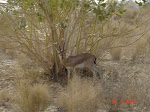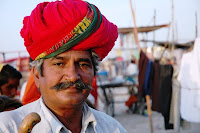The polling for Rajasthan State Assembly Elections was held yesterday-4th December 2008- in Barmer. The district recorded polling of over 60 percent. The Political pundits are predicting a close fight between the ruling Bharatiya Janata Party (BJP) and the Congress in all the 8 seats with an independent candidate playing a crucial role in one of the constituency.
The polling started at 8 am in the morning and there were long queues in most of the polling booths- in some booth the long queue was also due to the problems in the electronic voting machines. The polling ended by 5 pm and overall the polling process was peaceful in Barmer.
Thursday's polling will decide the fate of the BJP government of Chief Minister Vasundhara Raje. It will also affect the fortunes of the sitting minister Mr. Amra Ram Choudhary and the leader of Opposition Mr. Hemaram Choudhary. Besides these there are few other political stalwarts whose fate is locked in the voting machines- prominent among those being Col. Sonaram Choudhary, Mewaram Jain, Jalam Singh and Amin Khan.
The Congress & the BJP is contesting in all the 8 seats and in all the seats there is more of less direct fight between their candidates; with one independent candidate in Balotara may have a significant impact on the voters. Besides the congress and the BJP there are candidates from the Bahujan Samaj Party, CPI and the Lok Janshakti Party.
During the election campaign, while the BJP focused on its development initiatives and failure of Congress to deal with terrorism, the Congress was raising the issues of corruption in the present Government.
Though the political analyst are divided over the likely outcome but the likely mood seems in favour of the Congress party in majority of the constituencies in Barmer. While the Congress leaders are very sure of their win in Barmer, Shiv, Gudamalani, Pachpadra and Baitu constituency the BJP is equally confident in Chohtan, Siwana, Guda and Shiv.
The results would be declared on 8th. The fate of the contestants and the political parties would be decided that day. But the entire election process which generated lots of heat, undercurrent and interest among the people from various quarter is coming to an end and would stop by 8th. Elections are truly a vital event in our democracy which makes people wake from inertia, participate- in various capacities and at the same time it generates lots of hope for the future. Off course, there is some negative aspects including the clear caste distinction and practices adapted by several candidates which are not fair!
Lets hope whoever comes to power keeps alive the aspirations of the people and further strengthens our vibrant democratic.
Shankar
दुष्यंत कुमार
16 years ago













